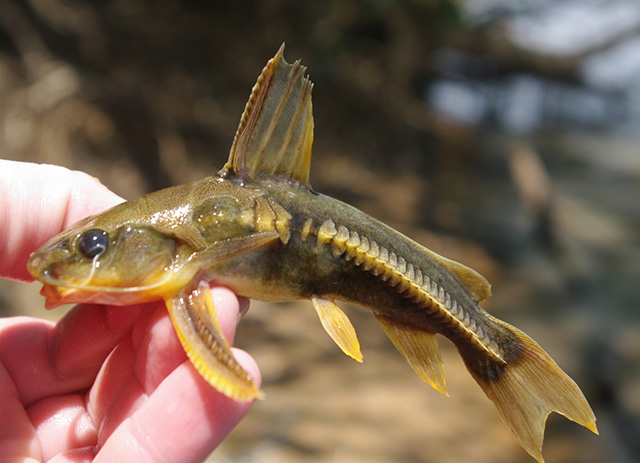| Doradidae (Thorny catfishes), subfamily: Doradinae |
| 18.2 cm TL (male/unsexed); max.weight: 117.4 g |
|
demersal; freshwater; depth range 0 - 1 m |
| South America: Brazil. |
|
Dorsal spines (total): 2-2; Dorsal soft rays (total): 6-6; Anal soft rays: 8-9; Vertebrae: 33-34. This species is distinguished from all its congeners by the following: gas bladder simple (vs. with secondary bladder) and dorsal and caudal fins uniformly dusky (vs. with distinct marks composed of dark blotch or broad band on the central part of the dorsal fin and pair of dark broad stripes on caudal fin, one central to each lobe) (Ref. 122376). |
| This species is common in rapids where it hides among rocks and cavities in bedrock. It is also found in lentic habitats such as small floodplain lakes closely associated with main channel. This species occurs in syntopy with Platydoras cf. armatulus in the Xingu. Gut contents include variable amounts of detritus, sand grains, Trichoptera (caddisfly) larvae (including cases), a few small snails (ingested whole) and minute bivalves ca. 0.5 mm long (presumably corresponding to an early settling stage). The gut of one juvenile (ANSP 200070, 66.5 mm SL) was filled with Trichoptera larvae, including intact cases of Helicopsychidae (0.9–1.9 mm diameter), found in the stomach (n=3) and intestine (n=15), and two 4–5 mm larvae with cases of Odontoceridae (Marilia sp.) in the stomach as well as remnants of conspecific larvae/cases in the intestine (Ref. 122376). |
|
Least Concern (LC); Date assessed: 03 November 2020 Ref. (130435)
|
| harmless |
|
Type locality of Platydoras birindellii, Pará, rio Xingu, Pedra Preta, São Félix do Xingu. It appears to be endemic to the Xingu Basin where it is common in the main channel and its large tributary, the Iriri. It is absent from the lowermost stretch of the Xingu river, the so-called Xingu Ria. Its downstream limit presumably corresponds with the Xingu channel’s departure from the Brazilian Shield near Belo Monte. Populations are expected to decline in the Volta Grande Rapids, the stretch of the rio Xingu inundated or dewatered by the Belo Monte dam complex since it began its operations in 2015. Large populations of this species occur upstream of the impact zone of Belo Monte, in both the Xingu and its tributary the Iriri, but are threatened by unprecedented changes in land use associated with deforestation, farming, ranching and mining (Ref. 122376). |
Source and more info: www.fishbase.org. For personal, classroom, and other internal use only. Not for publication.

